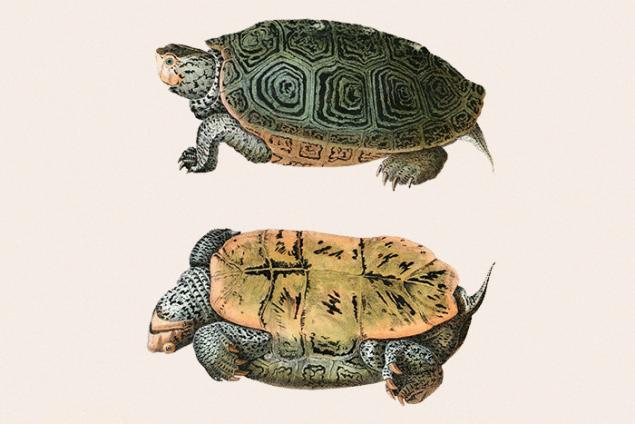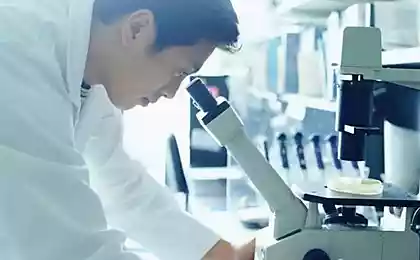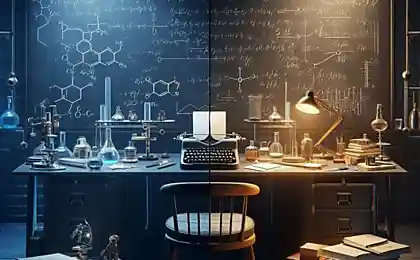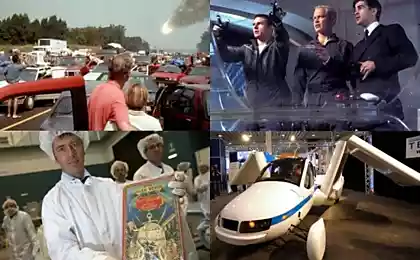532
Theoretical biology: a scientific tragedy with the shooting
Theoretical biology describes the General laws of occurrence of the existence of living organisms. She has the rare right to ask the most daring questions about life, seek answers and draw Parallels between chemistry, physics, biology, Economics and social Sciences. However, at the dawn of its existence in Russia, this area of science was banned and became deadly. T&P tells the story of the development of theoretical biology in our country and a list of its current challenges.

photo: en.wikipedia.org
77 years ago, all the creators of this material, from the proofreader to the editor, after publishing it, probably, immediately went under arrest, and then — in a concentration camp or to be shot at the famous 58-th article of the criminal code of the RSFSR, item 10 (other items): "counterrevolutionary activities," "distribution, manufacturing and possession of literature." In Russia of the Stalinist era "Theoretical biology" Erwin Bauer was a dangerous book, because in 1938, the author was shot together with his wife, their young children — separated, sent to the receiver of the NKVD and then in a special orphanage, and the whole character of the book is almost entirely destroyed. Copies are preserved only in some major libraries and at the daredevils who are not afraid to hold a shot book of the author.
The content of "Theoretical biology", at first glance, it seems, is not among the main causes of this tragedy: according to researchers, Bauer was arrested as Hungarian Communists, possible members of the 3rd Internationale. The family was a victim of the so-called Great terror — the campaign of mass arrests and brutal killings, which lasted in the Soviet Union from 1937 to 1938.
Then on political charges, according to the international historical and educational "memorial", was arrested on 1 million 700 thousand people.
The principle of Erwin Bauer: foundations of synergetics
In 1937-1938 the theoretical biology of Ervin Bauer by itself could hardly be dangerous for the political processes in Soviet Russia. However, it was useful for the revolutionary development of science — despite the fact that creating it, the scientist was partly mistaken in their views. At that time natural science was dominated by the belief that every natural phenomenon correspond to a special substance or even natural phenomena are a consequence of the physical properties of such substances. Erwin Bauer, like many of his colleagues, suggested that the same can be said about life — and concludes that it must comply with "living matter".
In the early twentieth century this matter seemed to biologists "protoplasm" — a jelly-like mass, which they found in the cells of living beings. Everywhere she looked the same, and so could well be the desired carrier properties of "life". "Protoplasm" is minimized at high temperatures, resembling the proteins of milk, blood and bird eggs, so her purported Central component called "protein", trying not to confuse it with the "average protein".
Erwin Bauer wanted to explore the thermodynamic properties of "living matter", since this is the field of theoretical physics with the onset of the twentieth century has been developed the most. He assumed that the molecules of "living matter" is constantly in a natural unstable state, so that the fabric fade without food and light and blossom with their appearance. The principle of sustainable imbalance, formulated by Erwin Bauer, is: "All and only alive systems never are in balance and execute at the expense of their free energy to constantly work against equilibrium required by the laws of physics and chemistry under existing external conditions." This Soviet biologist concludes that the basic properties of living systems are metabolism, cell division, reproduction and aging. This is contrary to the principle of thermodynamic equilibrium (i.e., quiescent), so that the self-movement of living systems looks like its a violation.Evidence of Ilya Prigogine: self-organization of living systems
The existence of a stable disequilibrium was proved in 1947 by the Belgian physicist and physical chemist of Russian origin Ilya Prigogine. In 1977 for his work in the field of thermodynamics he was awarded the Nobel prize in chemistry. Among the works of Prigogine was working on self-organization in open systems, which formed the basis of a new interdisciplinary field of science — synergetics. The focus of her attention are General regularities of phenomena and processes in nonequilibrium complex systems (physical, chemical, biological, environmental, social and other) that arise on the basis of its principles of self-organization.A living system, indeed, is open (it is influenced by the environment) and to balance her away. Every living organism regularly receives power (in the case of plants — sunlight) and nutrients (in the case of animals — food) uses them to maintain its functions and secretes waste, which can then be used by other systems.
Living systems are able to respond flexibly to environmental changes: for example, single-celled amoeba from hunger can come in the multicellular "body", which moves as a single unit in search of food. At the same amoeba in its composition are divided into two groups form a kind of foot, while others fruiting body, inside of which the spores Mature. Then, these spores are dispersed and, if conditions are favorable, are "born" a new amoeba. The response of an open system — a single-celled amoeba — lack of nutrients leads to the emergence of a new level of organization on the coordinated behavior of many individual cells. Probably needless to mention that this principle is observed in the case of much more complex organisms — including people hunger and disaster are pushing for revolution and other concerted mass action.The most audacious questions: what is theoretical biology today
Today, theoretical biology covers all the theoretical perspectives that somehow relate to biological processes, and describes the General laws of existence, movement and development of living matter. The focus of this discipline — cell biology, developmental biology, ecology, immunology, the study of infectious diseases, mathematical modeling and statistics, various branches of medicine, Phytopathology, Microbiology, molecular biology, biochemistry and psychology.
The search for answers to bold fundamental questions on the border of philosophy — a direct duty of theoretical biology. How did and how evolved life? Why do people look so as they look? What explains the complexity and diversity of living systems on our planet? Unique to terrestrial life?
A precise definition of biological terms and a description of the process of knowledge by means of formal tools is also one of the main tasks of theoretical biology. By its nature this area of science is interdisciplinary. It moves between the specific and the General, absorbing major ideas from other fields and developing them using quantitative descriptions and clarification. So theoretical biology is gradually becoming extensive structural science of organized systems, which has rare and valuable right to draw Parallels and find similarities between the physico-chemical, biological, economic and social systems. Perhaps she will become the arbitrator in resolving many long-standing conflict between creationists and Darwinists, ufologists and supporters of the anthropic principle and other debaters. After all, in the end, despite the giant leaps made by science over the past half century, we still haven't decided a large part of the most exciting mysteries of the world.
What is life? As animal became man? Could it happen again here, with another species or in another country? published
P. S. And remember, only by changing their consumption — together we change the world! ©
Source: theoryandpractice.ru

photo: en.wikipedia.org
77 years ago, all the creators of this material, from the proofreader to the editor, after publishing it, probably, immediately went under arrest, and then — in a concentration camp or to be shot at the famous 58-th article of the criminal code of the RSFSR, item 10 (other items): "counterrevolutionary activities," "distribution, manufacturing and possession of literature." In Russia of the Stalinist era "Theoretical biology" Erwin Bauer was a dangerous book, because in 1938, the author was shot together with his wife, their young children — separated, sent to the receiver of the NKVD and then in a special orphanage, and the whole character of the book is almost entirely destroyed. Copies are preserved only in some major libraries and at the daredevils who are not afraid to hold a shot book of the author.
The content of "Theoretical biology", at first glance, it seems, is not among the main causes of this tragedy: according to researchers, Bauer was arrested as Hungarian Communists, possible members of the 3rd Internationale. The family was a victim of the so-called Great terror — the campaign of mass arrests and brutal killings, which lasted in the Soviet Union from 1937 to 1938.
Then on political charges, according to the international historical and educational "memorial", was arrested on 1 million 700 thousand people.
The principle of Erwin Bauer: foundations of synergetics
In 1937-1938 the theoretical biology of Ervin Bauer by itself could hardly be dangerous for the political processes in Soviet Russia. However, it was useful for the revolutionary development of science — despite the fact that creating it, the scientist was partly mistaken in their views. At that time natural science was dominated by the belief that every natural phenomenon correspond to a special substance or even natural phenomena are a consequence of the physical properties of such substances. Erwin Bauer, like many of his colleagues, suggested that the same can be said about life — and concludes that it must comply with "living matter".
In the early twentieth century this matter seemed to biologists "protoplasm" — a jelly-like mass, which they found in the cells of living beings. Everywhere she looked the same, and so could well be the desired carrier properties of "life". "Protoplasm" is minimized at high temperatures, resembling the proteins of milk, blood and bird eggs, so her purported Central component called "protein", trying not to confuse it with the "average protein".
Erwin Bauer wanted to explore the thermodynamic properties of "living matter", since this is the field of theoretical physics with the onset of the twentieth century has been developed the most. He assumed that the molecules of "living matter" is constantly in a natural unstable state, so that the fabric fade without food and light and blossom with their appearance. The principle of sustainable imbalance, formulated by Erwin Bauer, is: "All and only alive systems never are in balance and execute at the expense of their free energy to constantly work against equilibrium required by the laws of physics and chemistry under existing external conditions." This Soviet biologist concludes that the basic properties of living systems are metabolism, cell division, reproduction and aging. This is contrary to the principle of thermodynamic equilibrium (i.e., quiescent), so that the self-movement of living systems looks like its a violation.Evidence of Ilya Prigogine: self-organization of living systems
The existence of a stable disequilibrium was proved in 1947 by the Belgian physicist and physical chemist of Russian origin Ilya Prigogine. In 1977 for his work in the field of thermodynamics he was awarded the Nobel prize in chemistry. Among the works of Prigogine was working on self-organization in open systems, which formed the basis of a new interdisciplinary field of science — synergetics. The focus of her attention are General regularities of phenomena and processes in nonequilibrium complex systems (physical, chemical, biological, environmental, social and other) that arise on the basis of its principles of self-organization.A living system, indeed, is open (it is influenced by the environment) and to balance her away. Every living organism regularly receives power (in the case of plants — sunlight) and nutrients (in the case of animals — food) uses them to maintain its functions and secretes waste, which can then be used by other systems.
Living systems are able to respond flexibly to environmental changes: for example, single-celled amoeba from hunger can come in the multicellular "body", which moves as a single unit in search of food. At the same amoeba in its composition are divided into two groups form a kind of foot, while others fruiting body, inside of which the spores Mature. Then, these spores are dispersed and, if conditions are favorable, are "born" a new amoeba. The response of an open system — a single-celled amoeba — lack of nutrients leads to the emergence of a new level of organization on the coordinated behavior of many individual cells. Probably needless to mention that this principle is observed in the case of much more complex organisms — including people hunger and disaster are pushing for revolution and other concerted mass action.The most audacious questions: what is theoretical biology today
Today, theoretical biology covers all the theoretical perspectives that somehow relate to biological processes, and describes the General laws of existence, movement and development of living matter. The focus of this discipline — cell biology, developmental biology, ecology, immunology, the study of infectious diseases, mathematical modeling and statistics, various branches of medicine, Phytopathology, Microbiology, molecular biology, biochemistry and psychology.
The search for answers to bold fundamental questions on the border of philosophy — a direct duty of theoretical biology. How did and how evolved life? Why do people look so as they look? What explains the complexity and diversity of living systems on our planet? Unique to terrestrial life?
A precise definition of biological terms and a description of the process of knowledge by means of formal tools is also one of the main tasks of theoretical biology. By its nature this area of science is interdisciplinary. It moves between the specific and the General, absorbing major ideas from other fields and developing them using quantitative descriptions and clarification. So theoretical biology is gradually becoming extensive structural science of organized systems, which has rare and valuable right to draw Parallels and find similarities between the physico-chemical, biological, economic and social systems. Perhaps she will become the arbitrator in resolving many long-standing conflict between creationists and Darwinists, ufologists and supporters of the anthropic principle and other debaters. After all, in the end, despite the giant leaps made by science over the past half century, we still haven't decided a large part of the most exciting mysteries of the world.
What is life? As animal became man? Could it happen again here, with another species or in another country? published
P. S. And remember, only by changing their consumption — together we change the world! ©
Source: theoryandpractice.ru























